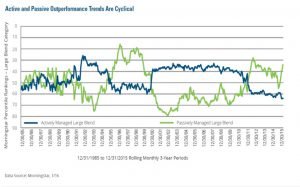Passive Investing Primer

 Over the last several years, a debate between “passive” and “active” management has been raging in the investment industry. So far, the passive approach is winning – with the majority of net investment dollars recently flowing into index-oriented mutual funds and Exchange Traded Funds (ETFs). Passive investing has become so popular that we thought it would be timely to provide a primer on the practice for new investors.
Over the last several years, a debate between “passive” and “active” management has been raging in the investment industry. So far, the passive approach is winning – with the majority of net investment dollars recently flowing into index-oriented mutual funds and Exchange Traded Funds (ETFs). Passive investing has become so popular that we thought it would be timely to provide a primer on the practice for new investors.
What is passive investing?
Passive investing is about remaining invested in the market at all times, using products (index mutual funds or index or sector ETFs), that focus on capturing returns equal to a specific benchmark or market sector, minus a fee. Passive products can be as broad or specific as you want, and generally carry lower fees than actively managed alternatives. For example, you can invest in the entire stock market with one index fund, or invest in niches, such as only growth companies, value companies, or specific industry sectors. One of the most well-known of the broad index funds is the Vanguard 500 Index Fund. It is comprised of the 500 largest U.S. companies as measured by market capitalization, with position size determined by the market cap of each constituent. Passive investing can be useful for investors who are looking for a strategy that closely shadows a particular benchmark and its returns, but who don’t necessarily have the time, aptitude or willingness to analyze companies on an individual basis.
Active investing, on the other hand, is a strategy that typically involves more frequent buying and selling of (usually a more limited) selection of stocks in a portfolio. Active investors believe they can outperform benchmarks over time, and select securities to achieve that goal.
What are the pros and cons of passive?
Aside from being attractive to buy and hold investors, passive investing also permits instant diversification. Costs are lower as well, as index investors generally don’t pay for research or manager due diligence associated with active management. A computer can easily pick the 500 largest U.S. companies by market cap on any given day, and that is exactly what happens! On the flipside, the lower costs associated with passive investing don’t necessarily translate into better returns. By definition, passive index investors attempt to mirror the returns obtained by a benchmark index; therefore, passive investors’ returns will not significantly outperform that benchmark. Active investing, however, has been shown to outperform benchmarks in certain sectors of the stock and bond markets.
Another con with passive investing is lack of control over holdings. Regardless of your opinion on a specific company, with index investing you are buying every name in a basket of stocks or bonds. Because most index funds are market-cap weighted (as described above), investors end up buying more of what has performed best recently and less of what has performed the worst. This “momentum” bias is not always optimum. Passive and active investing trends are cyclical, meaning one philosophy may outperform the other for a significant period of time. The following graph shows how passive investing has outperformed recently, but active management outperformed for a period of time before that.
We also wouldn’t recommend passive exposure to certain segments of the market due to illiquidity. Current examples would include high yield bonds, bank loans, emerging market debt, and emerging market equity. Another potential con is the lack of downside protection. With a passive investment product, investors participate in ALL gains and losses of a benchmark. Active managers, on the other hand, may be able to hold bonds or cash, or otherwise select securities that perform better – protecting against the full impact of a benchmark’s losses.
Can an investor essentially “set it and forget it” with passive investing?
We would say no. We suggest monitoring your portfolio to be sure your asset allocation is not overstretched or out of alignment. Even with a 5- or 10-year investment horizon, passive investors should still be active in rebalancing their portfolio when positions significantly deviate from their original targets. This is not necessarily an every month (or even every year!) exercise, but we believe it needs to be done. Work with an advisor who can help you build a proper asset allocation – one that fits your time horizon and mental and emotional makeup. Monitor your portfolio to be sure you are on track to meeting your long-term financial goals.
After a more than 5-year run of outperformance, passive investing has caught the attention of investors and media alike. According to Morningstar, last year alone, $340 billion flowed out of active, while $505 billion flowed into passive products. But we don’t think it will always be this way; active investing will again have its day in the sun, most likely when markets turn a little less “friendly.” Investors therefore need to understand each of these approaches, and how they fit with their goals and objectives. We can help you do exactly that.

